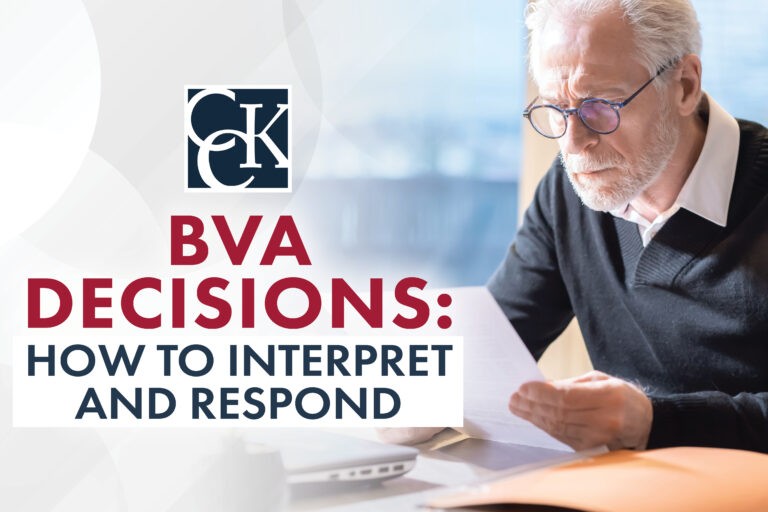BVA Decisions: How to Interpret and Respond

CCK Law: Our Vital Role in Veterans Law
The Board of Veterans’ Appeals (BVA) is one of the main paths for appealing VA decisions. The BVA bases its decisions on the evidence of record submitted before the Regional Office (RO)’s adjudication, along with any new evidence, if applicable. The Board also reviews previous VA and Board decisions to ensure that VA law was applied correctly. After reviewing, a Veterans Law Judge at the BVA will issue a decision.
Here are some tips from CCK about how to interpret and respond to a BVA decision letter.
Types of BVA Decisions
The following are types of Board decisions and, if needed, what steps veterans can take to continue their appeal.

Grants from the BVA
The Board may decide to fully or partially grant the benefits sought on appeal. Usually, if the Board grants a claim, it will send the claim back to the RO for implementation. For example, in many situations, the Board may grant service connection, but the RO will determine the effective date of the claim and any disability ratings. In an increased rating claim, the Board will assign the veteran a specific rating and instruct the RO to determine the proper effective date.
Veterans do not immediately receive their retroactive benefits (i.e., back pay) following a grant from the Board of Veterans’ Appeals. Usually, these benefits are paid following the RO’s rating decision. It is important to note that VA does not operate on any specific timeline in regard to awarding back pay, and wait times can vary depending on the complexity of the veteran’s case.
Remands from the BVA
A “remand” is a legal term that describes the process in which a superior court remands — or sends back — an appeal to a lower court for another look. A Board remand occurs when the Board of Veterans’ Appeals determines that additional information is needed before making a final decision on a veteran’s claim for benefits.
If the Board chooses to remand the claim, it will return to the VA RO for further evidence collection and to complete any remand instructions. A remand is an order that the RO must follow. If the RO fails to follow the instructions given by the Board in the remand, then the veteran has the right to appeal again.
Following a remand, the RO will work through each of the Board’s instructions and may request additional information from the veteran. After the RO completes the Board’s remand instructions, it will issue a decision on the veteran’s claim.
If VA continues to deny the veteran’s claim, it will return the case to the Board. The Board will grant, deny, or remand the case again. There is no limit on the number of times a Board judge may remand a veteran’s case.
Denials from the BVA
Finally, the Board may also partially or fully deny a veteran’s claim. This occurs when the Board determines that the veteran is not entitled to the benefits they are seeking on appeal.
However, if the BVA denies a veteran’s claim, it is not the end of the road. There are several options to continue appealing following a BVA denial.
How to Disagree with a BVA Decision
If a veteran disagrees with the BVA’s decision, they can appeal. Typically, veterans choose from the following ways to appeal their decision:
- Submit a supplemental claim.Veterans can file a supplemental claim with new and relevant evidence within one year of the date of the decision. If they do so, their effective date will be preserved.
- Request a Motion for Reconsideration. Veterans can request a Motion for Reconsideration. A Motion for Reconsideration effectively asks the Board to reconsider aspects of the case not adequately addressed in its decision. If a veteran’s Motion for Reconsideration is denied, the veteran may still appeal to the CAVC, but this may lengthen the process.
- Request a Motion to Vacate. By requesting a Motion to Vacate, the veteran is asking the BVA to “wipe the slate clean” due to a procedural error. If the veteran’s appeal period passed but the Board denial was the result of a clear and unmistakable error (CUE), the veteran can request a revision based on the CUE.
- Appeal to the CAVC.Veterans can appeal a Board denial to the Court of Appeals for Veterans Claims (CAVC) within 120 days of the date of the decision. Veterans who choose to appeal to the CAVC can preserve their original effective date.
Appealing to the Court of Appeals for Veterans Claims (CAVC)
The CAVC is a federal court located in Washington, D.C., and dedicated to hearing the appeals of claimants (i.e., veterans and their dependents) who have been unsuccessful in their cases before the Board of Veterans’ Appeals.

Importantly, the CAVC is not part of the Department of Veterans Affairs. Rather, it is an entirely separate federal entity with jurisdiction over VA. When appealing to the CAVC, VA will have an attorney defending the agency’s position and opposing the veteran’s position. Essentially, veterans are taking legal action against the Secretary of the U.S. Department of Veterans Affairs.
While veterans do have the right to appeal to the CAVC on their own (i.e., “pro se”), the process can be extremely difficult to navigate for those without knowledge, resources, or experience. An experienced attorney can significantly increase a veteran’s chances of winning their CAVC appeal. Learn more about how to pick an attorney for a CAVC appeal.
Again, claimants only have 120 days from the date of the Board decision to file a CAVC appeal before the decision becomes final. To file a CAVC appeal, claimants must complete a Notice of Appeal with the Court, which includes personal identifying information and details about the Board decision.
Generally, the CAVC either affirms or vacates and remands a Board decision back down to the Board. In rare situations the Court will reverse a decision, meaning it sends the case back to the Board with instructions to change a finding or grant a benefit.
What if the CAVC Denies the Claim?
If a veteran receives a denial from the CAVC, they can again submit a supplemental claim within one year. Alternatively, veterans can appeal to the Federal Circuit (i.e., the next level of the federal system) within 60 days of the judgment. However, to do so, a legal error must have occurred during the Court’s decision making.
CCK Can Help with Your BVA Appeal
VA appeals can be highly complex, and errors may lead to delayed or lost benefits, missed deadlines, and additional frustration. If you require assistance appealing a decision made by the Board of Veterans’ Appeals, contact CCK today. We offer complimentary consultations to determine if we can help with your appeal.
About the Author
Share this Post
